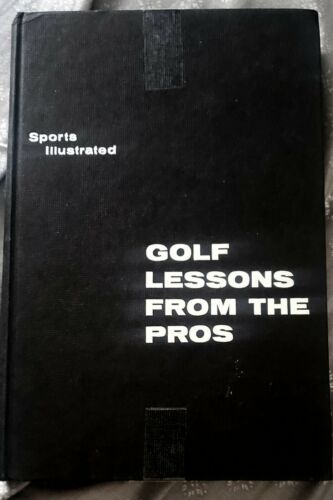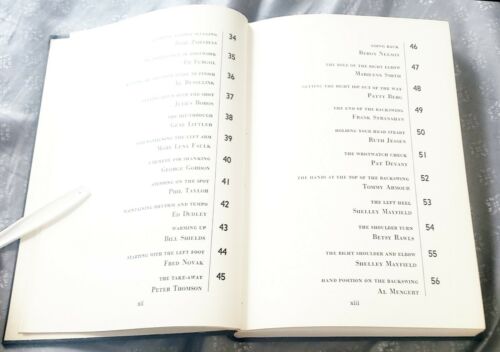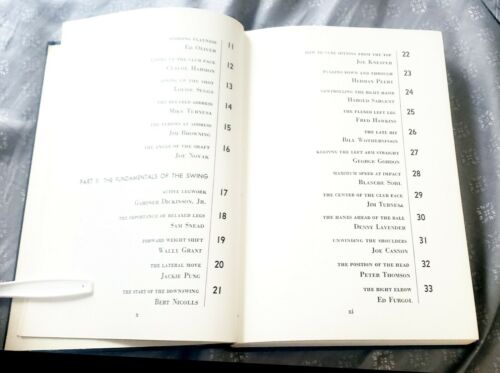-40%
HOW TO PLAY BO0K:GOLF LESSONS FROM THE PROS-SPORTS ILLUSTRATED 1961 GREAT TIPS!!
$ 0.98
- Description
- Size Guide
Description
HOW TO PLAY BO0K:GOLF LESSONS FROM THE PROS-SPORTS ILLUSTRATED 1961 GREAT TIPS!!BOOK - EX LIBRARY GOOD CONDITION, NO DUSTCOVER
Golf Swing Instruction: Understand the Fundamentals of a Golf Swing Such as Posure, Grip and Control to Achieve Range, Accuracy and Improve Your Game as a Whole
You can add more range to your golf swing and improve your game, Ending up in the sand or any other inconvenient location will be a thing of the past if you have the right knowledge and training based upon that knowledge. That is what this book is all about.
It's not all about the swing, however. You can hit the ball perfectly and it still may not go far enough. It's not all about muscles, either. There are a whole lot of skinny guys driving the ball further than jocks. There is a lot more to a good swing than it meets the eye, and after going through this book, there is no doubt you will notice some things you may have been doing less than ideally.
SOME GENERAL INFO ABOUT
olf
From Wikipedia, the free encyclopedia
Jump to navigationJump to search
"Golfer" redirects here. For other uses, see Golf (disambiguation) and Golfer (disambiguation).
Golf
Golfer swing.jpg
A golfer in the finishing position after hitting a tee shot
Highest governing body
The R&A
USGA
IGF
First played
15th century, Kingdom of Scotland
Characteristics
Contact
No
Type
Outdoor
Equipment
Ball, clubs, tee
Glossary
Glossary of golf
Presence
Olympic
1900, 1904, 2016,[1] 2020[2]
Golf is a club-and-ball sport in which players use various clubs to hit balls into a series of holes on a course in as few strokes as possible.
Golf, unlike most ball games, cannot and does not utilize a standardized playing area, and coping with the varied terrains encountered on different courses is a key part of the game. The game at the usual level is played on a course with an arranged progression of 18 holes, though recreational courses can be smaller, often having nine holes. Each hole on the course must contain a teeing ground to start from, and a putting green containing the actual hole or cup 4 1⁄4 inches (11 cm) in diameter. There are other standard forms of terrain in between, such as the fairway, rough (long grass), bunkers (or "sand traps"), and various hazards (water, rocks) but each hole on a course is unique in its specific layout and arrangement.
Golf is played for the lowest number of strokes by an individual, known as stroke play, or the lowest score on the most individual holes in a complete round by an individual or team, known as match play. Stroke play is the most commonly seen format at all levels, but most especially at the elite level.
The modern game of golf originated in 15th century Scotland. The 18-hole round was created at the Old Course at St Andrews in 1764. Golf's first major, and the world's oldest tournament in existence, is The Open Championship, also known as the British Open, which was first played in 1860 at the Prestwick Golf Club in Ayrshire, Scotland. This is one of the four major championships in men's professional golf, the other three being played in the United States: The Masters, the U.S. Open, and the PGA Championship.
Rules and regulations
Main article: Rules of golf
Arnold Palmer in 1953
The rules of golf are internationally standardised and are jointly governed by The R&A, spun off in 2004 from The Royal and Ancient Golf Club of St Andrews (founded 1754), and the United States Golf Association (USGA).[23][24] With the aim of simplifying the rules, in 2017 the USGA and R&A undertook a complete rewrite.[25] The new rule book came into effect in January 2019.[26]
The underlying principle of the rules is fairness. As stated on the back cover of the official rule book:
Play the ball as it lies, play the course as you find it, and if you cannot do either, do what is fair.
There are strict regulations regarding the amateur status of golfers.[27] Essentially, anybody who has ever received payment or compensation for giving instruction, or played golf for money, is not considered an amateur and may not participate in competitions limited solely to amateurs. However, amateur golfers may receive expenses that comply with strict guidelines and they may accept non-cash prizes within the limits established by the Rules of Amateur Status.
In addition to the officially printed rules, golfers also abide by a set of guidelines called golf etiquette. Etiquette guidelines cover matters such as safety, fairness, pace of play, and a player's obligation to contribute to the care of the course. Though there are no penalties for breach of etiquette rules, players generally follow the rules of golf etiquette in an effort to improve everyone's playing experience.
Penalties
Main article: Penalty (golf)
Penalty strokes are incurred in certain situations and are counted towards a player's score as if there were extra swing(s) at the ball. Either one or two strokes are added for most rule infractions or for taking relief from various situations, with the "general penalty" defined as two-strokes, and disqualification for severe or repeated rule breaches. Examples include:
A lost ball or a ball hit out of bounds (OB) results in a penalty of one stroke and distance (Rule 18.2).
With the exception of certain circumstances, a one-stroke penalty is assessed if a player causes their ball to move (Rule 9.4).
A one-stroke penalty is assessed if a player elects to take relief when their ball comes to rest within a red or yellow penalty area (Rule 17), or from an unplayable lie (Rule 19).
A two-stroke penalty is incurred for making a stroke at the wrong ball (Rule 6.3c).
A two-stroke penalty is incurred for hitting a fellow player's ball if both balls lay on the green prior to the stroke (Rule 11.1a).
Disqualification can result from cheating, signing for a lower score, or failing to adhere to one or more rules that lead to improper play.[28]
THANKS FOR LOOKING!!
THANKS FOR LOOKING!!!



















